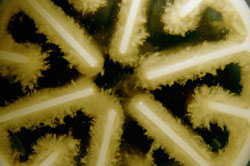 Millions of polypropylene widgets used to attract bacteria in wastewater treatment plants are drifting along in the Seine after being dumped by either the Essonne Intercommunal Union for Sanitation and River Restoration (1) or its subcontractors.
Millions of polypropylene widgets used to attract bacteria in wastewater treatment plants are drifting along in the Seine after being dumped by either the Essonne Intercommunal Union for Sanitation and River Restoration (1) or its subcontractors.
The Norwegian inventor describes the technology as “a 3-room apartment with a kitchen where bacteria can live comfortably and eat pollutants in wastewater.” The technology, described in France as Radical Flow Fluidized Filter (R3F), is considered easy and economical to operate. The lifespan of the “biomedias” (2) is 20 to 25 years. They are used in Bordeaux, Mulhouse and upstream of Paris, to name a few locations. These bacteria niches can amount to 19 million units per 100 m3 of water. Operators have obviously released them in large numbers into the natural environment.
These “biomedias” are part of a larger gang of micro marine debris on the world’s coastlines but are also found in the nests or digestive tracts of birds or fish just like cotton bud sticks, cigarette butts, lids, pen caps and polystyrene fragments.
The particular example of the Seine River illuminates the contribution of upstream and inland areas to the pollution of estuaries, coastlines and the ocean. There are many possible pathways of this new technology finding its way into the environment. These include the degraded operation of community wastewater plants and other uses such as water purification at industrial sites, fish farms and oil separators for ships. All these sectors are quoted in the references of the producers. Another source of diffusion could be the accidental loss of containers holding between 20-40 million widgets during transport. One of the major manufacturers is located in China. The eventual bacteriological pollution of these discharges into the river is of equal concern, since “biomedias” are also used in the wastewater treatment plants of hospitals.
According to the Norwegian inventor, users can lose control of these “biomedias” during periods of heavy rainfall and flooding. Other causes of discharges into waterways are misconception or improper maintenance of the sieves and screens at wastewater plants, before the release into the natural environment of water considered clean.
(1) Syndicat Intercommunal d’Assainissement et de Restauration des Cours d’Eau de l’Essonne (SIARCE)
(2) Also known as The Moving Bed biofilm technology, widget, media filter, biofilm, biofilter.
 Imprimer cet article
Imprimer cet article









